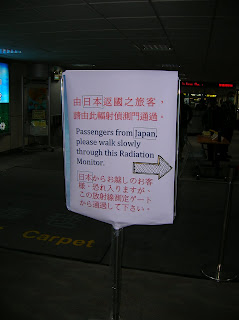 ings things I noticed on this trip was the sign to the left I saw upon arrival at the airport in Taipei, Taiwan. Since I had a very short stopover in Tokyo, I had to walk through the machine. To my surprise, it produced a "beep", but the attendants told me just to keep going. But as I thought about it, I realized that this is an example of what geographers refer to as "time-space compression". What does it mean when you "compress" something? That's right, it means that you apply some sort of pressure to it to make it smaller. In this case, time-space compression is a term we use to describe how technological advances in transportation and telecommunications bring us closer together and change the ways that we interact with one another. If you think about it, not too long ago the fastest that people (and news, for that matter) could travel was the speed of a fast horse or ship! But now we can travel around the globe in a matter of hours, and we can communicate with people on the other side of the planet instantly! It is indeed a small world after all! But time-space compression has far-reaching impacts on our culture, politics, lifestyles, and in the way we behave. Can you think of some effects of time-space compression?
ings things I noticed on this trip was the sign to the left I saw upon arrival at the airport in Taipei, Taiwan. Since I had a very short stopover in Tokyo, I had to walk through the machine. To my surprise, it produced a "beep", but the attendants told me just to keep going. But as I thought about it, I realized that this is an example of what geographers refer to as "time-space compression". What does it mean when you "compress" something? That's right, it means that you apply some sort of pressure to it to make it smaller. In this case, time-space compression is a term we use to describe how technological advances in transportation and telecommunications bring us closer together and change the ways that we interact with one another. If you think about it, not too long ago the fastest that people (and news, for that matter) could travel was the speed of a fast horse or ship! But now we can travel around the globe in a matter of hours, and we can communicate with people on the other side of the planet instantly! It is indeed a small world after all! But time-space compression has far-reaching impacts on our culture, politics, lifestyles, and in the way we behave. Can you think of some effects of time-space compression?
Anyway, back to Taipei. These days it's not too often that I get to visit a country I've never been to before, but a long layover here gave me a chance to get out of the transit hotel and see the sights. This time I decided to fly Taiwan's China Air because they have the cheapest fare (by a long shot!). I suspect that this is due to China Airlines flying their planes slower to save on gas, though the only evidence I have to support my hypothesis is the fact that it took 9 hours to fly from Honolulu to Tokyo this time, and I don't remember it taking that long in the past. This is a somewhat sneaky form of "time-space decompression", but as long as it helps me save some money, I'm not going to complain too much....They did after all pay for the transit hotel.
After I got settled I rode the high-speed rail from the airport into Taipei, which is the capital of Taiwan. The train was going 250 kilometers per hour at one point(1)! I was really impressed. I got to the downtown train station at about 8pm local time and hopped on the city's wonderful subway system to head over to see Taipei 101, one of the tallest buildings in the world. Since it was raining and dark I wasn't able to get a good photo, but I've included a few below along with a special artist's rendering I worked up with the cutting edge drawing software that came with my computer. I got tired of drawing the windows after about a minute, but you get the idea. The drawing is not to scale.
As it turns out, Taipei is a really cool town based on the 2.5 hours I was able to spend walking around. It has a really neat mix of architectural styles and lots of things going on. I walked through a night market, which is always an interesting experienced with neat things to see and...uh...smell. There are charming little temples and shrines tucked in between modern skyscrapers and the city center is great for walking. I hope I get a chance to come back and spend some more time at some point.
Well, that's it for now. I hope that all of the young geogra-philes out there will check back frequently for updates. Over the next few months I'll be posting more about the unique geography of Indonesia. Stay tuned! In the mean time I'll leave you with this mind-blowing video clip I made in the transit hotel.
1. In a previous post I told you that there are approximately 1.61 kilometers in a mile, and about .62 miles in each kilometer. Based on this, can you figure out how fast the high-speed rail train was traveling?



No comments:
Post a Comment